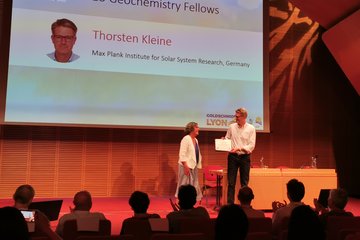Alle Typen
301.
Konferenzbeitrag
Inversion of 1.5 μm spectral data of a sunspot. In: Proc. ``Probing the Sun with High Resolution'' (Hg. Venkatkrishnan, S.; Tripathy, S. C.; Venkatkrishnan, P. V.). Alpha Science, Pangbourne (2002)
302.
Konferenzbeitrag
Thermal-magnetic relation of a sunspot from the inversion of IR spectral data. In: 1st Potsdam Thinkshop on Sunspots and Starspots Poster Proceedings, S. 117 - 118 (Hg. Strassmeier, K. G.; Washuettl, A.). Brandenburgische Universitätsdruckerei, Golm (2002)
303.
Konferenzbeitrag
Thermal-magnetic relation of a sunspot as inferred from inversion of 1.5 μm spectral data. In: SOLMAG 2002, Proceedings of the Magnetic Coupling of the Solar Atmosphere, Euroconference and IAU Colloquium 188,, S. 501 - 504 (Hg. Sawaya-Lacoste, H.). ESA Publ. Div., Noordwijk (2002)
304.
Konferenzbeitrag
The EROS time-of-flight analyser. In: Proc. 32nd ESLAB Symp., `Remote Sensing Methodology for Earth Observations and Planetary Exploration', ESTEC, Noordwijk, The Netherlands, 15-18 September 1998, S. 157 - 162 (Hg. Attema, E.; Schwehm, G.; Wilson, A.). ESA Publ. Div., Noordwijk (1998)
305.
Konferenzbeitrag
The Energetic Particles Detector (EPD) Aboard the Galileo Spacecraft. In: The Three Galileos: The Man, the Spacecraft, the Telescope, S. 319 - 330 (Hg. Barbieri; C.; others). Kluwer, Dordrecht (1997)
306.
Konferenzbeitrag
Comparison of recurrent ion events using Ulysses HI-SCALE and EPAC and Voyager LECP data. In: Proc. 24th International Cosmic Ray Conf., S. 431 - 434. ANY PUBLISHER, Rome (1995)
307.
Vortrag
Solar wind and planetary period modulations of reconnection events in Saturn’s magnetotail. AGU Fall Meeting, San Francisco, CA, USA (2019)
308.
Vortrag
The importance of convection in the radiation belts of Jupiter and Saturn. AGU Fall Meeting, San Francisco, CA, USA (2019)
309.
Vortrag
Quantifying transient electron radiation belt extensions at Saturn. AGU Fall Meeting, San Francisco, CA, USA (2019)
310.
Vortrag
Calibration of Electrostatic Analyzers to Study Planetary Magnetospheres and Icy Moons. EPSC-DPS Joint Meeting 2019, Geneva, Switzerland (2019)
311.
Vortrag
Calibration of Electrostatic Analysers to Study Planetary Magnetospheres and Icy Moons. EPSC-DPS Joint Meeting 2019, Geneva, Switzerland (2019)
312.
Vortrag
Energetic ion depletions near the Galilean moons. EPSC-DPS Joint Meeting 2019, Geneva, Switzerland (2019)
313.
Vortrag
Energetic ion depletions near the Galilean moons: atmospheric interaction and indications of the charge state. EPSC-DPS Joint Meeting 2019, Geneva, Switzerland (2019)
314.
Vortrag
Magnetospheric interactions of Saturn's moon Dione 2004-2017. EPSC-DPS Joint Meeting 2019, Geneva, Switzerland (2019)
315.
Vortrag
Magnetospheric environment of Callisto. JUICE-Clipper science workshop, EPSC-DPS Joint Meeting 2019, Geneva, Switzerland (2019)
316.
Vortrag
A micro-radiation belt of electrons generated by Saturn’sF-ring. EPSC-DPS Joint Meeting 2019, Geneva, Switzerland (2019)
317.
Vortrag
New findings of energetic particles in Saturn’s radiation belts inside L=3: Cassini MIMI/LEMMS results. 27th IUGG General Assembly, Montréal, Canada (2019)
318.
Vortrag
Solar Wind and Planetary Period Modulations of Reconnection Events in Saturn's Magnetotail. Conference on the Magnetosphere of the Outer Planets , Sendai, Japan (2019)
319.
Vortrag
Dayside magnetodisk reconnection processes on Saturn revealed by Cassini. Conference on the Magnetosphere of the Outer Planets , Sendai, Japan (2019)
320.
Vortrag
CRAND injection coefficients at Saturn. Conference on the Magnetosphere of the Outer Planets , Sendai, Japan (2019)











